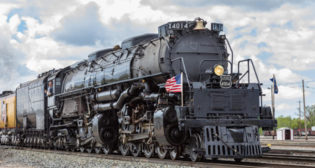
Takeaways From FTR’s Deep Freight Rail Dive
Written by Jim Blaze, Contributing Editor
Bruce Kelly photo
FTR Transportation Intelligence Chairman and CEO Eric Starks and Vice President Rail and Intermodal Todd Tranausky recently hosted a webinar to examine the rail freight market in terms of volume and recovery pace, as well as their professional outlook for North American freight car manufacturing. As an invited media journalist and commentator, here are my takeaways for Railway Age readers.
Through Week 22 of 2021, here is a sample look at how U.S. rail freight traffic is trending. The data graphics are courtesy of FTR, as are most of the trend observations. A few of the comments reflect economic interpretation from my “old” railroad economist viewpoint.

FTR carefully reminded particiopants that transport activity follows from what is occurring in the overall economy. Based upon that reminder, there are several distinctive commodity markets for rail in terms of volume recovery since the pandemic year of 2020.
Rail intermodal volume has clearly recovered from its depth of last spring. However, the growth rate since 2018 has been very low, at less than a 2% compounded rate of growth.

Selective carload commodity shipments have recovered from 2020 lows. As an example of different recovery rates, rail grain shipments are up considerably, led by the export trade.
The North American rail equipment manufacturing sector is starting to turn the corner in 2021, but an overall recovery to a “normal” long-term building pattern will likely have to wait until 2022. FTR predicts that each unique car type has different economic fundamentals that will impact that car type’s recovery (upcycle). FTR’s car manufacturing outlook reflects a deeper research dive into Railinc (an AAR subsidiary company) forecasts, which should help car owners and lessors examine their business portfolio against changes in the U.S. and North American economy.

That is good news. However, let us keep things in perspective. Trucking still dominates much of North American freight transport activity. And the trucking recovery pattern is exceptionally good. Rail freight overall is not near a record high, not for carload traffic.
Here is the picture from FTR’s files for general rail carload traffic between 2019 and May 2020, with an outlook into year 2022:
Here is the much stronger pattern for rail intermodal in the May 2020 to May 2021 timeline:
RAIL CAR MANUFACTURING OUTLOOK TOWARD 2025
Using its new data analytics, here is the current FTR outlook as of mid-May for new rail freight car production. Note the perceived lag in the new carload delivery rate.
It is important to note there are spot market shortages of some rail car types. For example, Todd Tranausky noted that steel industry gondola cars are currently in high demand, and there is a shortage in part because of the high average age of that specific car type. Lumber freight cars are also seeing a surge in that commodity type. Perhaps i surprisingly, FTR’s data shows that there is one specific commodity that is still depending upon the boxcar: beverages, one of those core boxcar traffic commodities that during a near 13-year period has held up its use of the boxcar. Durable goods orders and capital goods core numbers also look very strong for the U.S. economy. This also might in some market O/D pairs suggest a recovery for certain boxcar types.

Note that FTR’S enhanced database now can be used to examine the market supply and market demand type by different commodity groups and car types. The graphs here only reflect general freight car population patterns.
SPECIAL UNCERTAINTY
There still is a great deal of technical uncertainty about the railcar fleet. One critical uncertainty is that some car types are very old. Decisions by car owners must be made about what cars to scrap vs. repair or replace new. This may be particularly true for steel gondolas and certain boxcar types.
There is also uncertainty regarding who makes car replacement decisions. For example, most railcars are not owned or managed by Class I railroads. Car ordering or scrapping decisions are mostly going to be made by shippers, freight receivers or car leasing companies. The market demand is in their hands, rather than the Big Seven railroad companies.
There is less uncertainty about the need for coal cars. As clearly noted in the following FTR graph, coal traffic overall is down today by just over one half. Tranusky calls this aptly a “seismic shift in the fleet requirements for coal cars.” However, North America’s loss of coal demand might represent opportunity elsewhere around the globe.

Here is an alert message for parts of the world that still rely upon coal movement by railroads. There is a surplus of newer coal gondolas and hopper cars in North America that could be purchased at discount prices and shipped overseas for use on AAR-spec, heavy-haul (30 to 33 metric ton axle-load) tracks, albeit in counties without domestic builders(Australia for example; not China). They can be purchased at less than two-thirds of the price of buying an all-new coal car, with a good 25 to 30 or more years operating life left.
WHAT HAS BEEN THE IMPACT OF PSR?
Tranusky, along with other industry experts, questions the impact on improving overall UMLER (Railinc’s North American railcar fleet database) utilization rates. It appears reasonable to conclude that the promised fleet utilization improvement that was supposed to be a dividend of more theoretically precise scheduling performance offered by the PSR “sweat the assets” railway business model might not be occurring. There is little direct evidence tying together PSR cash flow rail company benefits to UMLER car fleet evidence. Who has that kind of evidence?
MISSING CAR TYPE ORDERS?
There is an unanswered question regarding the strategic outlook for rail intermodal. Who is ordering new or even life-cycle-replacement cars for the North American intermodal fleet? Ironically, despite the strong recovery in the intermodal rail market, there have been only about 30 double-stack well cars ordered over the past year, according to FTR analysis. Perhaps the low CAGR of intermodal suggest the reluctance to order more cars. This assumes that the existing TTX carpool has sufficient supply on hand.
Will the semi-trailer business return to intermodal railroads? That is not at all clear. Despite periodic surges and a seasonal movement rush to find train movement space for semi-trailers, there have been no noticeable orders placed for TOFC flat cars. If semi-trailers do not return, then the conclusion must be that future rail intermodal growth requires that the railroads and their intermodal partners must continue to convert trailer truck users to domestic containers.

Independent railway economist and Railway Age Contributing Editor Jim Blaze has been in the railroad industry for more than 40 years. Trained in logistics, he served seven years with the Illinois DOT as a Chicago long-range freight planner and almost two years with the USRA technical staff in Washington, D.C. Jim then spent 21 years with Conrail in cross-functional strategic roles from branch line economics to mergers, IT, logistics, and corporate change. He followed this with 20 years of international consulting at rail engineering firm Zeta-Tech Associated. Jim is a Magna cum Laude Graduate of St Anselm’s College with a master’s degree from the University of Chicago. Married with six children, he lives outside of Philadelphia. “This column reflects my continued passion for the future of railroading as a competitive industry,” says Jim. “Only by occasionally challenging our institutions can we probe for better quality and performance. My opinions are my own, independent of Railway Age. As always, contrary business opinions are welcome.”



